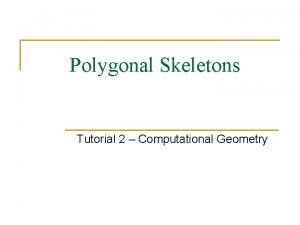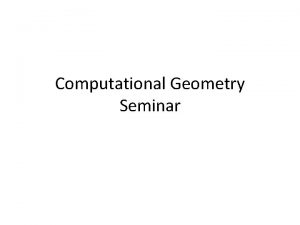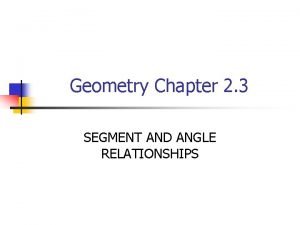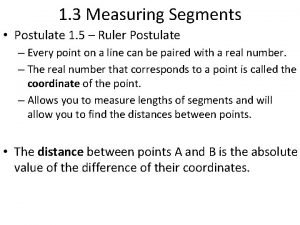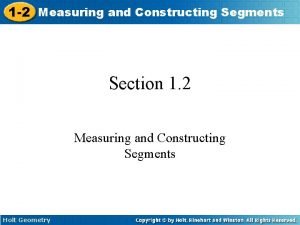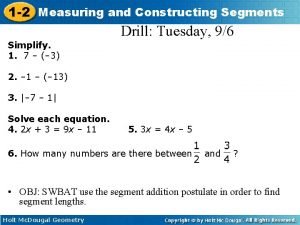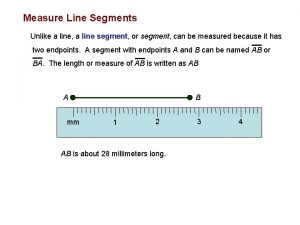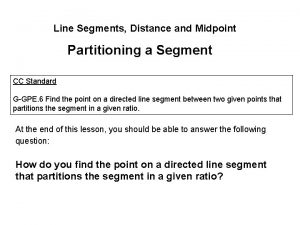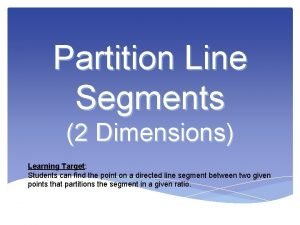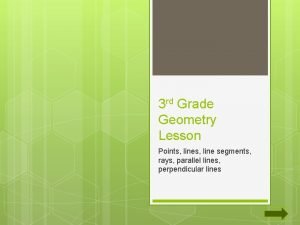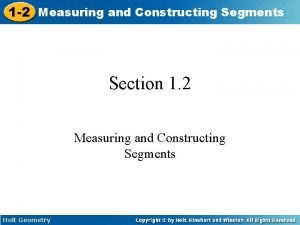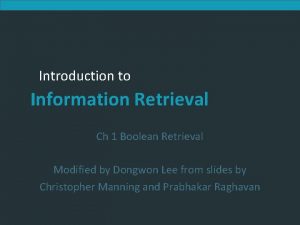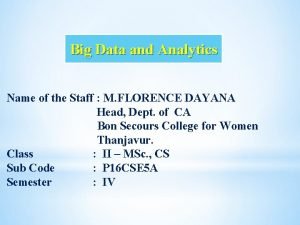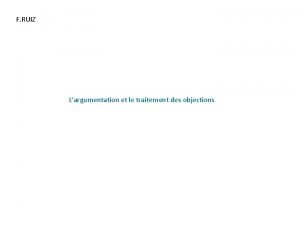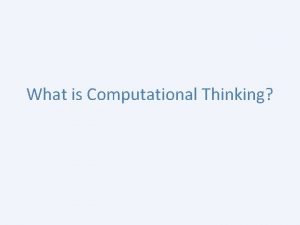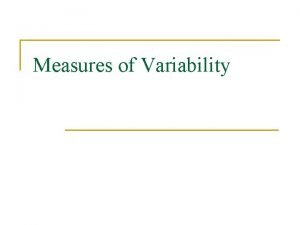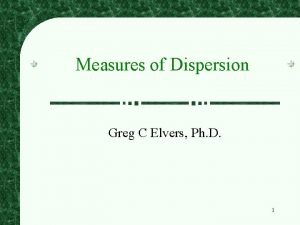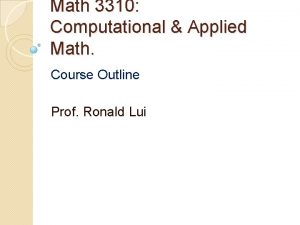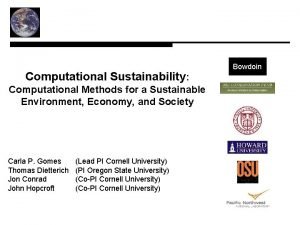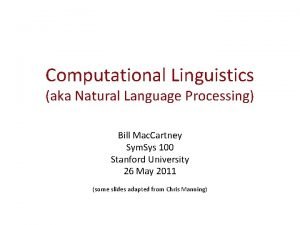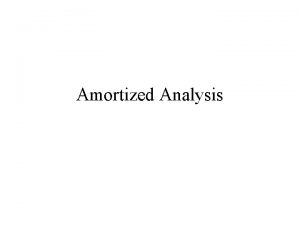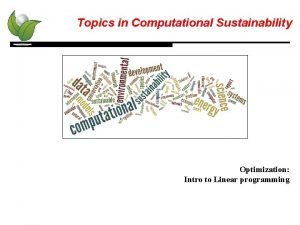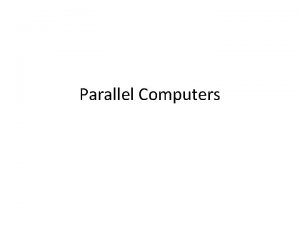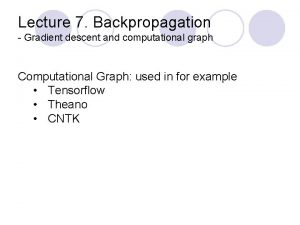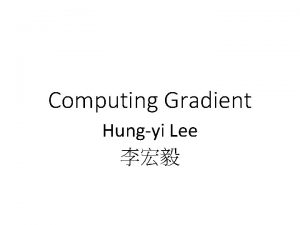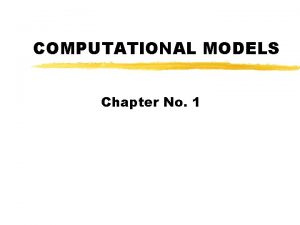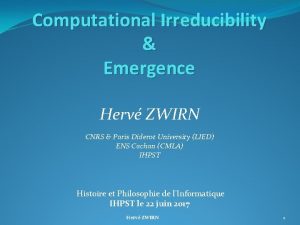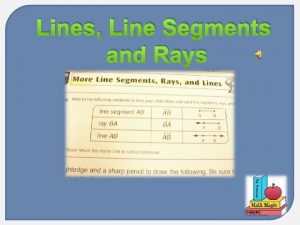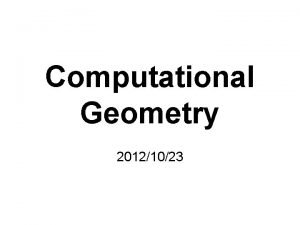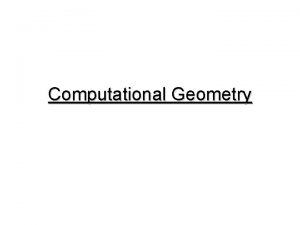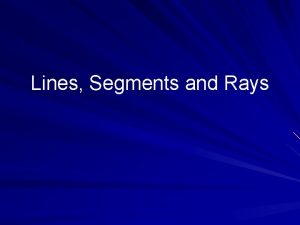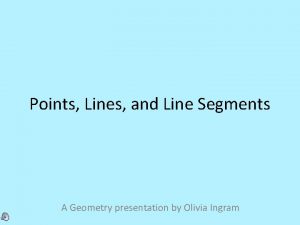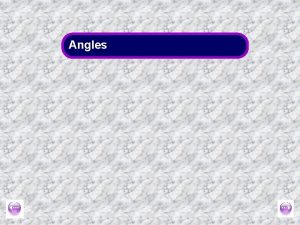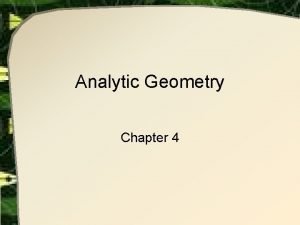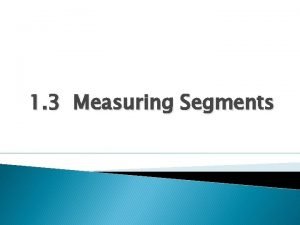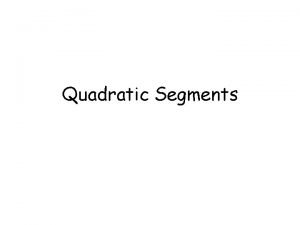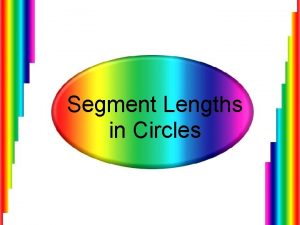Computational Geometry Chapter 14 Line Segments Dealing with















































































- Slides: 79

Computational Geometry Chapter 14

Line Segments

Dealing with Degeneracy

Polygons

Convex Polygons






Lattice Points and Pick’s Theorem • Lattice points are unit-spaced grid points. • In general, there will be about one grid point per unit-area in the grid. • The number of grid points within a given figure should give a pretty good approximation to the area of the figure.

Pick’s Theorem • The theorem gives an exact relation between the area of a lattice polygon P (a polygon with the vertices on lattice points) and the number of lattice points on/in the polygon. • Suppose – A(P): area of P – I(P): number of lattice points inside P – B(P): number of lattice points on the boundary of P • The theorem says: A(P) = I(P) + B(P)/2 -1

Pick’s Theorem

Convex Hulls

Convex Hulls • Problems: • Smallest bounding box. • Smallest bounding balls

Algorithm to Construct the Convex Hull Given a set S of n points. Construct CH(S), the convex hull of S. The vertices of CH(S) are called extreme points of S. p is an extreme point if an only if it allows a line through p such that all the remaining points strictly lie on one side of the line. • p is an interior point if any line through p splits the point set. The both sides of the line contains points of S. • p is a boundary point if it is not an extreme or an interior point. • •

extreme point interior point boundary point

Plane sweep • The idea is to sweep the plane with a line and perform the computations in the sequence the data is encountered. • Can use to construct the convex hull of points

Plane sweep • Can use to construct the convex hull of points • We sweep a vertical line from left to right over the data. • At any moment in time, the points in the front (to the right) are untouched, and the points to the left of the line are already processed.

Algorithm to Construct the Convex Hull • Algorithm: – Sort the points by increasing x-order – Let S : <p 1, p 2, …, pn} where pi. x <= pi+1. x for all i. – Let Si = {p 1, p 2, …, pi}, the set of first i points. – Start with the convex hull of the first 3 points p 1, p 2 , p 3. – for i = 4 … n do the following • add the next point pi to te convex hull of the preceding points by finding the two lines that pass through pi and support CH(Si-1).

Illustration: adding p 6

Finding Support Lines • We use a dequeue data structure; a queue-like data structure which allows insertion and deletion of points from both ends. This was discussed in the class. • The dequeue contains the convex hull found so far. The counterclockwise order is obtained by starting from the right end. The clockwise order is obtained by starting from the left end. • For the diagram in the previous slide the content of the dequeue is <…… 5, 4, 3, 2, 5, …>

Finding Support Lines • The effort to insert one point could be large, but it is then we remove many previously added vertices from the list. • We can remove at most n-3 points in total. • Each point gets inserted exactly once. • The total effort to find the supporting linea is therefore O(n).

Algorithm to Construct the Convex Hull • Sorting step costs O(nlogn) • Finding the supporting line step takes linear time. • The convex hull of n points can be computed in O(nlogn) time.



Triangulation • The plane sweep algorithm can be used to decompose the convex hulls into triangles. • Points are never removed. • All we need to change is that instead of deleting the point due to left-right turn of three points, we add the triangle realized by the points of the left-right turn. • The running time is O(n).

Triangulation

Smallest Enclosing Box • Step 1: Compute the convex hull of S. – Let e 1, e 2, …, eh be the edges of the convex hull. • Step 2: For each ei, compute the smallest enclosing box with one side aligned with ei. • Step 3: Report the box with the smallest area. • How quickly can you implement Step 2? – Rotating Caliper Method

Rotating Calipers • A line L is a line of support of a convex polygon P if the interior of P lies completely to one side of L. • A pair of vertices p and q is an antipodal pair if it admits parallel lines of support through p and q.

• pi and pj is an antipodal pair (Fig. 1). To generate the next antipodal pair, we consider the angles that the lines of support at pi and pj with edges pipi+1 and pjpj+1 respectively. • Let θi < θj. • When we rotate clockwise, the lines of support, then the next antipodal pair is either (pi , pj+1 ) or (pj, pi+1).

Smallest Enclosing Box We use two pairs of calipers (Fig. 2). L(pi) denote the directed line of support at pi. L(pj), L(pk) and L(pl) are similarly defined. (pi, pj, pk, pl) form a 4 -tuple forming a rectangle containing P. • We then find the next 4 -tuple by rotating the supporting line by an angle θ = min (θi, θj, θk , θl). • We can find all such 4 -tuples in linear time. • The smallest box can be computed in O(nlogn) time. • •

Another sweep line application Slides taken from CS 97 SI --- Stanford U.














Intersection of two Convex Sets Fact 0: Intersection of any two convex sets is convex (possibly empty). Proof: A, B [ (A, B P Q) (A, B P) (A, B Q) (AB P) (AB Q) (AB P Q) ]. P Q B A ax Examples of convex sets: Lines, line segments, convex polygons, half-planes, etc. Line: ax + by = c Half-plane: ax + by c (or ax + by c ) + ax by c ax + by c y= +b c

Intersection of two Convex Polygons Let P and Q be convex polygons with, respectively, n and m vertices. Consider the convex (possibly empty) polygon R = P Q. Fact 1: R has at most n+m vertices. Proof: Let e be any edge of P. e’ = e Q is convex, hence, either empty, a single vertex of Q, or a sub-segment of e. In the latter case e’ is an edge of R. (Similarly, with e an edge of Q and e’ = e P. ) Each edge e of P or Q can contribute at most one such edge e’ to R. P and Q have n and m edges, respectively. Hence, R can have at most n+m edges.

Intersection of two Convex Polygons Fact 2: R = P Q can be computed in O(n+m) time. Proof: Use the plane-sweep method. The upper and lower chains of P and Q are x-monotone (from leftmost to rightmost vertex each). In O(n+m) time, merge these 4 x-sorted vertex-lists to obtain the n+m vertices of P and Q in x-sorted order. This forms the sweep-schedule. These n+m vertical sweep-lines partition the plane into n+m-1 vertical slabs. The intersection of each slab with P or Q is a trapezoid. The two trapezoids within a slab can be intersected in O(1) time. Hence, we can obtain P Q in O(n+m) time. slab

Intersection of n Half-Planes Problem: Given n half-planes H 1, H 2, … , Hn, compute their intersection R = H 1 H 2 … Hn. Input: Hi: ai x + bi y ci , i = 1. . n Output: convex polygon R (empty, bounded or unbounded). R

Intersection of n Half-Planes Problem: Given n half-planes H 1, H 2, … , Hn, compute their intersection R = H 1 H 2 … Hn. Divide-&-Conquer in O(n log n) time: (Use Facts 1 and 2. ) (H 1 … H n/2 ) (H n/2 +1 … Hn Convex P, |P| n/2 T(n/2) time Convex Q, |Q| n/2 T(n/2) time Convex R = P Q, |R| |P|+|Q| n O(n) time T(n) = 2 T(n/2) + O(n) = O(n log n).

An Art Gallery Problem We are given the floor-plan of an art gallery (with opaque walls) represented by a simple polygon P with n vertices. Is it possible to place a single point camera guard (with 360 vision) in the gallery so that it can “see” every point inside the gallery? q The set of all such points is called the “Kernel” of P. q If Kernel(P) is not empty, then P is called a “star” polygon. P

An Art Gallery Problem We are given the floor-plan of an art gallery (with opaque walls) represented by a simple polygon P with n vertices. Is it possible to place a single point camera guard (with 360 vision) in the gallery so that it can “see” every point inside the gallery? q The set of all such points is called the “Kernel” of P. q If Kernel(P) is not empty, then P is called a “star” polygon. q Kernel(P) is the intersection of n half-planes defined by P’s edges. P

An Art Gallery Problem We are given the floor-plan of an art gallery (with opaque walls) represented by a simple polygon P with n vertices. Is it possible to place a single point camera guard (with 360 vision) in the gallery so that it can “see” every point inside the gallery? q The set of all such points is called the “Kernel” of P. q If Kernel(P) is not empty, then P is called a “star” polygon. q Kernel(P) is the intersection of n half-planes defined by P’s edges. q Kernel(P) can be computed in O(n log n) time by divide-&-conquer. q It can be computed in O(n) time by a careful incremental method that scans the edges of P in order around its boundary. How? P

Range Queries • Orthogonal range queries are a common operation in working with n x m rectilinear grids.

Range Queries • Let pi = (xi, yi), I = 1, 2, 3, 4. • Let m[i][j] = Points (x, y) in the rectangle where x ≥ i and y ≥ j.

Range Queries • Let pi = (xi, yi), I = 1, 2, 3, 4. • Let m[i][j] = Points (x, y) in the rectangle where x ≥ i and y ≥ j. Points inside the rectangle <p 1 p 2 p 3 p 4> = m[x 3][y 3] - m[x 4][y 4] -m[x 2][y 2] +m[x 1][y 1]

Range Queries • Let pi = (xi, yi), I = 1, 2, 3, 4. • Let m[i][j] = Points (x, y) in the rectangle where x ≥ i and y ≥ j. Points inside the rectangle <p 1 p 2 p 3 p 4> = m[x 3][y 3] - m[x 4][y 4] -m[x 2][y 2] +m[x 1][y 1] We can precompute m[i][j] for all values of i and j. --- O(mn) time for an m x n grid.

Data Structure to Store Polygons

Doubly Connected Edge List (DCEL) • DCEL is one of the most commonly used representations for polygons or collection of polygons • It is an edge-based structure which links together the three sets of records: – Vertex – Edge – Face • It facilitates traversing the faces of the collection of polygons visiting all the edges around a given vertex.

Doubly Connected Edge List (DCEL) f 1 f 2 f 4 f 3 edge face f 5 vertex • Record for each face, edge, and vertex – Geometric information – Topological information – Attribute information • Half-edge structure

Doubly Connected Edge List (DCEL) f 1 f 2 f 4 f 3 f 5 • Main ideas: – Edges are oriented counterclockwise inside each face – Since an edge borders two faces, each edge is replaced by two half-edges, one for each face

Doubly Connected Edge List (DCEL) • • • The vertex record of a vertex v stores the coordinates of v. It also stores a pointer Incident. Edge(v) to an arbitrary half-edge that has v as its origin The face record of a face f stores a pointer to some half-edge on its boundary which can be used as a starting point to traverse f in counterclockwise order Incident. Face(e 1) next(e 1) e 2 e 3. twin e 3 e 1 e 4 e 6 e 5 e 4. twin The half-edge record of a half-edge e stores pointer to: • Origin (e) • Twin of e, e. twin or twin(e) • The face to its left ( Incident. Face(e) ) • Next(e) : next half-edge on the boundary of Incident. Face(e) • Previous(e) : previous half-edge origin(e 1) previous(e 1)

Doubly Connected Edge List (DCEL) e 7, 2 v 3 v 6 e 7, 1 e 1, 2 e 5, 1 e 1, 1 f 1 v 1 e 3, 2 e 2, 1 e 5, 2 e 6, 1 f 2 v 4 e 4, 1 e 2, 2 f 3 e 4, 2 v 2 e 6, 2 e 9, 1 e 9, 2 f e 8, 1 4 e 8, 2 v 5 Vertex Coordinates Incident. Edge v 1 (x 1, y 1) e 2, 1 v 2 (x 2, y 2) e 4, 1 v 3 (x 3, y 3) e 3, 2 v 4 (x 4, y 4) e 6, 1 v 5 (x 5, y 5) e 9, 1 v 6 (x 6, y 6) e 7, 1 f 5

Doubly Connected Edge List (DCEL) e 7, 2 v 3 v 6 e 7, 1 e 1, 2 e 5, 1 e 1, 1 v 1 f 1 e 3, 2 e 2, 1 e 5, 2 e 6, 1 f 2 v 4 e 4, 1 e 2, 2 f 3 e 4, 2 e 6, 2 e 9, 1 e 9, 2 f e 8, 1 4 e 8, 2 v 5 v 2 Face Edge f 1 e 1, 1 f 2 e 5, 1 f 3 e 5, 2 f 4 e 8, 1 f 5 e 9, 2 f 5

Doubly Connected Edge List (DCEL) e 7, 2 v 3 v 6 e 7, 1 e 1, 2 e 5, 1 e 1, 1 f 1 v 1 e 3, 2 e 2, 1 e 5, 2 f 3 e 6, 1 f 2 v 4 e 4, 1 e 2, 2 e 4, 2 e 6, 2 e 9, 1 e 9, 2 f 5 f e 8, 1 4 e 8, 2 v 5 v 2 Half-edge Origin Twin Incident. Face Next Previous e 3, 1 v 2 e 3, 2 f 1 e 1, 1 e 2, 1 e 3, 2 v 3 e 3, 1 f 2 e 4, 1 e 5, 1 e 4, 1 v 2 e 4, 2 f 2 e 5, 1 e 3, 2 e 4, 2 v 4 e 4, 1 f 5 e 2, 2 e 8, 2 … … …

Doubly Connected Edge List (DCEL) e 7, 2 v 3 v 6 e 7, 1 e 1, 2 e 5, 1 e 1, 1 v 1 f 1 e 3, 2 e 2, 1 e 5, 2 v 4 e 4, 2 v 2 e 6, 1 f 2 e 4, 1 e 2, 2 f 3 e 6, 2 e 9, 1 e 9, 2 f 5 f e 8, 1 4 e 8, 2 v 5 • Storage space requirement: – Linear in the number of vertices, edges, and faces

Doubly Connected Edge List (DCEL) e 7, 2 v 3 v 6 e 7, 1 e 1, 2 e 5, 1 e 1, 1 f 1 v 1 e 3, 2 e 2, 1 e 5, 2 v 4 e 4, 2 v 2 e 6, 1 f 2 e 4, 1 e 2, 2 f 3 e 6, 2 e 9, 1 e 9, 2 f 5 f e 8, 1 4 e 8, 2 v 5 • Operations: – Walk around the boundary of a given face in CCW order – Access a face from an adjacent one – Visit all the edges around a given vertex

Doubly Connected Edge List (DCEL) e 7, 2 v 3 v 6 e 7, 1 e 1, 2 e 5, 1 e 1, 1 v 1 f 1 e 3, 2 e 2, 1 e 5, 2 e 6, 1 f 2 v 4 e 4, 1 e 2, 2 f 3 e 4, 2 v 2 e 6, 2 e 9, 1 e 9, 2 f 5 f e 8, 1 4 e 8, 2 v 5 • Interesting Queries: – Given a DCEL description, a line L and a half-edge that this line cuts, efficiently find all the faces cut by L.

Doubly Connected Edge List (DCEL) • Traversing face f: – Given: an edge of f 1. Determine the half-edge e incident on f 2. Start_edge e 3. While next(e) start_edge then e next (e)

Doubly Connected Edge List (DCEL) • Traversing all edges incident on a vertex v – Note: we only output the half-edges whose origin is v – Given: a half-edge e with the origin at v 1. Start_edge e 2. While next( twin(e) ) start_edge then e next( twin(e) )

Adding a Vertex (e 1, 2) d = prev ) e 1, 1 a= t( nex e 1, 1 x f 2 e 1, 2 f 1 b = prev(e 1, 1) ) xt(e 1, 2 c = ne

Adding a Vertex • • • New vertex x New edges: e 1, 2’ and e 1, 2’’ Incident. Edge(x) = e 1, 2’ ) e 1, 1 a= • • Origin(e 1, 2’) = x Next(e 1, 2’) = next (e 1, 2) Prev(e 1, 2’) = e 1, 2’’ Incident. Face(e 1, 2’) = f 2 • • Origin(e 1, 2’’) = origin(e 1, 2) Next(e 1, 2’’) = e 1, 2’ Prev(e 1, 2’’) = prev(e 1, 2) Incident. Face(e 1, 2’’) = f 2 • • Next(Prev(e 1, 2)) = e 1, 2’’ Prev(Next(e 1, 2)) = e 1, 2’ • Delete edge e 1, 2 (e 1, 2) d = prev t( nex e 1, 2’’ e 1, 1 f 1 x f 2 e 1, 2’ b = prev(e 1, 1) ) xt(e 1, 2 c = ne

Adding a Vertex • New edges: e 1, 1’ and e 1, 1’’ • • Origin(e 1, 1’) = origin(e 1, 1) Next(e 1, 1’) = e 1, 1’’ Prev(e 1, 1’) = prev(e 1, 1) Incident. Face(e 1, 1’) = f 1 • • Origin(e 1, 1’’) = e 1, 1’ Next(e 1, 1’’) = next(e 1, 1) Prev(e 1, 1’’) = e 1, 1’ Incident. Face(e 1, 1’’) = f 1 • • Next(prev(e 1, 1)) = e 1, 1’ Prev(next(e 1, 1)) = e 1, 1’’ • • • Twin(e 1, 2’) = e 1, 1’ Twin(e 1, 1’) = e 1, 2’ Twin(e 1, 2’’) = e 1, 1’’ Twin(e 1, 1’’) = e 1, 2’’ Delete edge e 1, 1 ) e 1, 1 a= t( nex e 1, 1’’ f 1 (e 1, 2) d = prev e 1, 2’’ x e 1, 1’ f 2 e 1, 2’ b = prev(e 1, 1) ) xt(e 1, 2 c = ne

Adding a Vertex • • If e 1, 1 was starting edge of f 1, need to change it to either one of the new edges If e 1, 2 was starting edge of f 2, need to change it to either one of the new edges ) e 1, 1 a= t( nex e 1, 1’’ f 1 (e 1, 2) d = prev e 1, 2’’ x e 1, 1’ f 2 e 1, 2’ b = prev(e 1, 1) ) xt(e 1, 2 c = ne

Other Operations on DCEL e b a • Add an Edge – Planar subdivision – e is added – DCEL can be updated in constant time once the edges a and b are known



 Computational geometry tutorial
Computational geometry tutorial Computational geometry
Computational geometry Segment bisector definition geometry
Segment bisector definition geometry Postulate 1-3
Postulate 1-3 Constructing segments
Constructing segments Geometry measuring and constructing segments
Geometry measuring and constructing segments Opposite rays definition
Opposite rays definition Chapter 5 lesson 1 dealing with anxiety and depression
Chapter 5 lesson 1 dealing with anxiety and depression Chapter 5 lesson 1 dealing with anxiety and depression
Chapter 5 lesson 1 dealing with anxiety and depression 66454 subject code
66454 subject code Electron geometry and molecular geometry
Electron geometry and molecular geometry Electron domain geometry vs molecular geometry
Electron domain geometry vs molecular geometry Covalent bond order
Covalent bond order Find rs
Find rs Partition a line segment formula
Partition a line segment formula Line segments and distance worksheet
Line segments and distance worksheet Partitioning a line segment formula
Partitioning a line segment formula Lesson 1-3 line segments
Lesson 1-3 line segments Name three lines
Name three lines Identifying market segments and targets chapter 9
Identifying market segments and targets chapter 9 Identifying market segments and targets chapter 9
Identifying market segments and targets chapter 9 Identifying market segments and targets chapter 9
Identifying market segments and targets chapter 9 1-2 measuring and constructing segments
1-2 measuring and constructing segments How to find the unit vector
How to find the unit vector Branch of linguistics dealing with meaning
Branch of linguistics dealing with meaning Abiotic components
Abiotic components Section 2 dealing with other nations
Section 2 dealing with other nations Contact center stress
Contact center stress How do marketers identify primary competitors
How do marketers identify primary competitors Science fiction is a genre of speculative fiction dealing
Science fiction is a genre of speculative fiction dealing Dealing with competition marketing management
Dealing with competition marketing management Unit 1 dealing with incoming calls
Unit 1 dealing with incoming calls Dealing with anger in the bible
Dealing with anger in the bible Dealing successfully with difficult changes in your life.
Dealing successfully with difficult changes in your life. Descriptive lexicology
Descriptive lexicology A play with a sad or unhappy ending
A play with a sad or unhappy ending Dealing with unstructured data
Dealing with unstructured data Reuters dealing tutorial
Reuters dealing tutorial Dealing with unstructured data
Dealing with unstructured data The branch of zoology dealing with insects
The branch of zoology dealing with insects The branch of zoology dealing with insects
The branch of zoology dealing with insects Dealing with challenging patients
Dealing with challenging patients Dealing successfully with difficult changes in your life
Dealing successfully with difficult changes in your life Dealing with unstructured data
Dealing with unstructured data Alan linning
Alan linning Receive and resolve customer complaints
Receive and resolve customer complaints 3p fair dealing
3p fair dealing Estimate synoynm
Estimate synoynm Dealing with objections
Dealing with objections Smita had been working as an assistant manager
Smita had been working as an assistant manager A nation's overall plan for dealing
A nation's overall plan for dealing Difficult volunteers
Difficult volunteers Characteristics of computational thinking
Characteristics of computational thinking Computational thinking algorithms and programming
Computational thinking algorithms and programming Grc computational chemistry
Grc computational chemistry Using mathematics and computational thinking
Using mathematics and computational thinking Usc neuroscience major
Usc neuroscience major Standard deviation computational formula
Standard deviation computational formula Semi interquartile range
Semi interquartile range Computational math
Computational math Computational thinking gcse
Computational thinking gcse Computational sustainability scope
Computational sustainability scope Chomsky computational linguistics
Chomsky computational linguistics Xkcd computational linguistics
Xkcd computational linguistics Cmu pitt computational biology
Cmu pitt computational biology C6748 architecture supports
C6748 architecture supports Amortized time big o
Amortized time big o Computational sustainability subjects
Computational sustainability subjects The computational complexity of linear optics
The computational complexity of linear optics Leerlijn computational thinking
Leerlijn computational thinking Computational speed
Computational speed Computational graph
Computational graph Computational graph
Computational graph Jeannette m. wing computational thinking
Jeannette m. wing computational thinking Crl alliance medical
Crl alliance medical Computational photography uiuc
Computational photography uiuc Computational neuroethology
Computational neuroethology Basic computational models in computer architecture
Basic computational models in computer architecture Computational methods in plasma physics
Computational methods in plasma physics Computational irreducibility
Computational irreducibility
